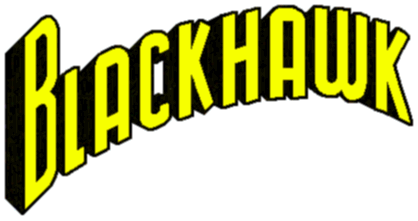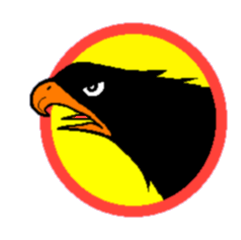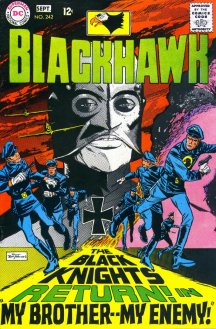

Issue No. 242
 Aug.-Sep. 1968
Aug.-Sep. 1968
My Brother - My Enemy!: A new creative team takes over the failing Blackhawk title. Bob Haney wrote the script from a story by Marv Wolfman, and the art was supplied by Pat Boyette, with Dick Giordano editing.
The story starts off well with masked and helmeted raiders completely destroying GEORGE headquarters. The Blackhawks, who had been on vacation, return to find their secret identity costumes destroyed along with GEORGE HQ. A recording of the destruction left behind identifies the mastermind as the Black Mask. Zinda picks them up in the Hawk Kite. She has been assaulted and a message left on a mirror tells Blackhawk to meet the Black Mask at a stated time and place. Donning their old uniforms, the team wonders who this mysterious character is.
In a private flashback, Blackhawk remembers a time early in WW II, when he and his brother, Jack Hawk ( for the first time Blackhawk's real name is given as Bart Hawk), both Air Force pilots, have volunteered to fly rocket powered drones to attack a Nazi heavy water plant. Jack's plane is accidentally released from its bomber carrier too soon and draws all the flak fire while Bart flies in unmolested to complete the mission. Bart bails out and watches his brother's plane crash into a lake. Bart is so upset he quits the Air Force.
Blackhawk goes looking for the Black Mask, who he knows is his brother. Jack was captured by the Nazis and convinced that he had been used by the Allies on purpose and that his brother had betrayed him. Jack lost a hand, which they replaced with a sword blade, and gave him a titanium helmet to cover his horribly scarred face. Jack becomes the Black Mask, a Nazi counterpart to the Allies' Blackhawk. The Blackhawks attack the Black Mask's base (the Blackhawks are shown flying Spitfires in full Blackhawk livery) and Jack is buried in ice. For some reason, he survives and now seeks revenge against the brother he believes betrayed him. On the long deserted Blackhawk Island, the Black Mask breaks out the War Wheel to use against the Blackhawks. Blackhawk and Hendy rev up the Flying Tank as a counter weapon, and stop the War Wheel. The Black Mask makes his escape in a helicopter. Blackhawk has a chance to shoot down the helicopter with a missile but claims it misfired and Jack gets away. Hendy picks up the missile launcher and fires the missile, putting the lie to Blackhawk.
This is an excellent story, well written and executed. It quickly gets rid of the silly accouterments with which the Blackhawks had been encumbered. It returns the team to their roots and at the same time engages them in an exciting story with a complex and interesting foe. There are problems with continuity, particularly in the changes in the origin of the Blackhawks that Jack's existence implies (originally, Blackhawk's brother was killed by the Germans bombing their farm house in Poland), but these are comparatively small and no worse than other inconsistencies introduced in earlier stories. The increased character development for Blackhawk was welcome and suggested that the rest of the team might get similar treatment in the future. Unfortunately, there was little future left.
Although I like the story in this issue (see my comments above) and think it was a valiant try at reviving the failing title, I have never had as high an opinion of the art. It's not the worst I've seen in a comic book (pick up a current copy of Batman or one of the Sandman Mystery Theater books for that), but it was a bit rough. Well, it turns out there is a story behind that. Apparently, there was a major change in personnel at DC around the same time. The reasons aren't important here. George Kashdan, the then editor of a number of DC's titles including Blackhawk, was replaced by Dick Giordano, brought in from Charlton. Giordano knew that Blackhawk was slated for cancelation and only had two issues remaining. Giordano was a fan of the series' classic years and thought that if he could make a big enough splash with the last two issues, perhaps Blackhawk would get a reprieve. He had nothing to lose in trying. He found the basis for this in a script by fan-turned writer Marv Wolfman, that had been submitted to Kashdan the previous year but never read, let alone used. It needed some work so he had it rewritten by veteran scripter Bob Haney. And then he needed an artist. Dick Dillin had moved on to work on the Justice League of America and Chuck Cuidera had retired from the comics business. Giordano had an inspiration, get Reed Crandall, the artist who made his name drawing Blackhawk, to do the last two issues. It was a great idea. Unfortunately, it didn't work out. Crandall was contacted and agreed to do the final issue(s). For what ever reason, Crandall never even started working on the project. Giordano finally realized this was the case with less than two weeks before the book had to go to the printers. He had worked with Pat Boyette at Charlton, and knew he was capable of turning out work in a very short time. He had the script sent to Boyette, who pencilled, inked and lettered the entire issue, including the cover, in a week (the exact number of days varies depending on who is telling the story, but it was at most ten days). This really is an amazing feat and puts the art in this issue in a whole new light. Unfortunately, Pat Boyette, passed away on January 14, 2000. See Mark Evanier's eulogy for Pat Boyette for more about his career and more about his work on the final issues of Blackhawk.
Since I wrote the above, Dick Giordano descibed this event in an interview in Comic Book Artist. Here it is in his own words:
CBA: How many titles did you edit?Dick: They gave me eight titles when I arrived: Young Love, Secret Hearts, Secret Six, Beware the Creeper, The Hawk and the Dove, Blackhawk, Bomba, and Aquaman. I was told that Bomba and Blackhawk were dead books when I was given them. I was there just to mop up and be given a couple of issues apiece. I got Jack Sparling to draw Bomba and I think he drew some of the best work of his life.
Blackhawk, I went to the source: Reed Crandall. I never met the man but I called him on the phone and asked him if he'd like to finish off two issues of Blackhawk. Either we'll go out in style or maybe revive it if we can get something interesting happening. He said, "Yeah, I'd love to do that." So I sent him a script and never heard from him again. I guess the script wasn't to his liking and he was semi-retired anyway. So when we got close to the deadline, I called Crandall (who lived in Kansas) and asked his mother to please have him mail the script to Pat Boyette who lived in Texas, the closest artist I could find-this was all before Federal Express. I called Pat and told him that he could do whatever he wanted with the two issues because we were dead before we started. He did a nice job.
And here's another bit of history about this issue. Comic Book Resources published a brief interview with Marv Wolfman who said:
"Secondly, on my own I wrote a revamp of Blackhawk and sent it to the BLACKHAWK editor, George Kashdan. I hated the book that he was doing - he turned the Hawks into something called "The Junk Heap Heroes" and it was awlful. I wrote a full script. A year or two later Dick Giordano found it unopened in his desk when he replaced Kashdan as editor. He read it and bought it."
All characters, pictures, and related indicia on these pages are the property of DC Comics. All text is ©1998-2001 Dan Thompson, except where otherwise noted. This homepage is not intended to infringe on the copyright of DC Comics to its characters, but was created out of gratitude to all the wonderful writers, artists, and editors who created the Blackhawks.